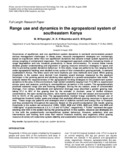| dc.description.abstract | Occurrence of equilibrium and non equilibrium system dynamics in semiarid environments present serious management challenges. In these areas, resource management strategies are increasingly based on equilibrium rather than non equilibrium dynamics that assume simple system dynamics and strong coupling of animal-plant responses. This management approach underlies increasing trends of range degradation and low livestock productivity in these environments. To reverse these trends dictates greater understanding and alignment of grazing resource extraction strategies in space and time to prevailing system dynamics behaviour. In this study, range use patterns by free ranging herds under agropastoral herding were studied in two cycles of four consecutive grazing periods, in semiarid southeastern Kenya. The bites count and herd locations per area methods were used. While grazing thresholds in the system were derived from biweekly sward biomass measured by the quadrant technique in the growing period and stocking rates applied to a growth-consumption rate model. The analysis tested the responsiveness of the agropastoral herding strategies to the predominant system dynamics in the area. In this environment, high rainfall variability ranging from 71 to 98% is experienced across years and seasons, pointing to non-equilibrium dynamics in the system. The agropastoralists practiced seasonal range use and tracking strategies. During the dry season, areas of concentrated drainage; river valleys, bottomlands and ephemeral drainage ways absorbed a greater grazing load, taking 57.1 to 60% of the grazing time by the animals. In contrast, areas of limited moisture concentration, the open sandy/clay plains, were mainly exploited in the wet season and accounted for 52.6 to 55.6% of the grazing time. The agropastoralists tracked forage availability through use of multispecies livestock (cattle, goats and sheep) that exploited different grazing resources in space and time. These range use patterns and strategies tend to stabilize nutrient and energy flow to livestock and thus productivity throughout the seasons. Based on the growth-consumption rate model, grazing thresholds in the system are achieved at 13800, 13000, 4000 and 12300, 4600 and 12000, and 5600 and 11000 kgha-1 of grass biomass at, 2.5, 5, 7, 8 and 10 TLUha-1, respectively. 7 TLUha-1 represent the upper stocking rate limit in the system during the growing period. In this system, resource use strategies are in line with the predominantly non-equilibrium system behaviour. However, sedentary land use interventions and limiting farm sizes that restrict livestock mobility and negatively affect grazing resource diversity will undermine system stability and sustainable livestock production in the area. | en_US |

